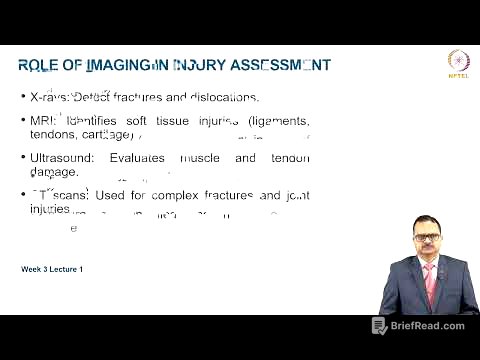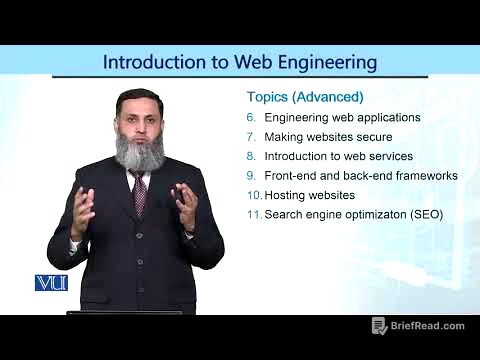TLDR;
This video provides a comprehensive guide to effective management, covering key areas like managing performance, people, and the business. It emphasizes the importance of modern management strategies that focus on motivating and engaging employees. The video explores various management styles, coaching techniques, performance feedback methods, and strategies for managing remote employees, time, projects, budgets, and HR regulations. It also highlights the significance of building trust, resolving conflict, and leading productive meetings.
- Key takeaways:
- Modern management focuses on motivating and engaging employees.
- Effective managers adapt their style to suit the situation and their employees' needs.
- Building trust is crucial for successful management.
- Managing up involves aligning your work with your manager's priorities and communication style.
- Managing remote employees requires effective communication, technology, and a focus on deliverables.
- Managing time, projects, and budgets are essential for business success.
- Understanding HR regulations is vital for protecting employee rights and mitigating risk.
- Making good business decisions requires emotional intelligence, business acumen, leadership, and a balance between caution and risk-taking.
Introduction [0:00]
This introductory chapter sets the stage for the video by defining management as a series of key skill sets rather than a single role. It emphasizes that good management involves applying the right skills and practices at the right time to help an organization reach its full potential. The chapter also highlights the evolution of management from its industrial revolution roots to the modern focus on motivating and engaging employees.
Management Definition [0:05]
This chapter delves into the definition of management, explaining that it encompasses three main areas: managing performance, managing people, and managing the business. It emphasizes that effective management involves understanding and applying specific competencies within each of these areas.
Managing - Leading [4:22]
This chapter explores the distinctions between managing and leading. While both are important in today's organizations, they have different goals and approaches. Leadership focuses on producing change and growth, while management aims to create order and consistency. The chapter outlines key differences in approach, time frame, focus, resources, task goals, and people skills.
Manager Roles [6:51]
This chapter identifies five primary roles that managers play: producer, administrator, innovator, mediator, and culture builder. It explains that each role requires different skill sets and that managers must balance these roles effectively. The chapter also highlights the importance of considering both the employees' and the organization's perspectives when making management decisions.
Management Styles [10:49]
This chapter explores different management styles, which are patterns of behavior used by managers in their interactions with employees. It identifies seven common styles: Director, Consultant, Consensus Builder, Coach, Visionary, Delegator, and Narcissist. The chapter describes the characteristics, strengths, weaknesses, and appropriate contexts for each style.
Choosing the Right Style [15:48]
This chapter focuses on choosing the right management style for different situations. It emphasizes that managers should be versatile and adapt their style based on the skills, attitudes, and needs of their employees. The chapter provides strategies for using different styles with employees at various stages of skill development.
Performance Management [20:40]
This chapter delves into the concept of performance management, which encompasses all practices, policies, and procedures that guide and support employee success. It explains that effective performance management aligns various aspects, including organizational goals, values, job descriptions, competencies, employee development, compensation, and employment decisions. The chapter also provides strategies for managers to implement performance management effectively.
Hiring Employees [24:58]
This chapter focuses on the hiring process, emphasizing the importance of using best practices to attract and hire the right people for the job. It outlines key steps, including using job descriptions effectively, following established procedures, and conducting thoughtful interviews. The chapter also stresses the importance of treating the hiring process as an investment in building a great team.
Onboarding [27:33]
This chapter explores the onboarding process, which is the formal introduction and orientation of new employees to the organization and team. It highlights the benefits of onboarding, including increased job satisfaction, performance, and retention. The chapter outlines best practices for onboarding, focusing on the four C's: compliance, clarification, culture, and connection.
Setting Employee Goals [29:05]
This chapter focuses on setting employee goals, explaining that it's a vital part of any performance management process. It discusses two common approaches: cascading goals and separate tracks for task performance and career development. The chapter also introduces the SMART goal technique, which helps managers and employees set specific, measurable, action-oriented, realistic, and timely goals.
Coaching [33:43]
This chapter explores the concept of employee coaching, explaining that it's a powerful tool for helping employees reach their full potential. It distinguishes between two primary styles of coaching: skill coaching and clarity coaching. The chapter also outlines four types of coaching conversations: problem-solving, performance, development, and career planning.
Performance Problems [37:35]
This chapter focuses on addressing performance problems, emphasizing the importance of early intervention and clear communication. It outlines strategies for managers to handle performance issues, including having initial conversations about expectations, honoring agreed-upon plans, addressing concerns immediately, and staying on top of issues until they're resolved.
Termination [42:09]
This chapter explores the process of terminating employees, acknowledging that it's one of the most challenging aspects of management. It emphasizes the importance of involving HR and legal professionals early in the process due to the legal complexities involved. The chapter outlines different types of terminations, including voluntary, involuntary, and death, and provides strategies for managers to handle terminations with care and respect.
Team Performance [47:12]
This chapter focuses on managing team performance, recognizing that collaborative work is increasingly common in today's organizations. It defines the characteristics of a true team, including a common purpose, interdependence, shared accountability, and a belief in the benefits of working together. The chapter also outlines strategies for managing high-performing teams and addressing common reasons for team failure.
Peer to Manager [48:34]
This chapter explores the transition from being a peer to a manager, acknowledging the unique challenges involved when supervising former colleagues. It provides strategies for new managers to navigate this transition, including having patience, getting to know their team members, gathering information, being transparent about their values, crafting an overall strategy, and pacing themselves.
Establishing Trust [52:53]
This chapter emphasizes the importance of establishing trust as an ongoing process that underpins successful management. It outlines key practices for building trust, including having integrity, sharing values, making ethical choices, listening sincerely, being accountable, communicating honestly, responding to feedback, and creating a culture of safety.
Motivating - Engaging [57:51]
This chapter explores the concepts of motivation and engagement, explaining that they are essential for building a thriving workplace. It highlights the three driving forces of motivation: physical survival and safety, belonging, and achieving full potential. The chapter also discusses the top causes of employee disengagement and provides strategies for managers to create a culture of engagement through individual relationships.
Delegation [1:02:21]
This chapter focuses on the art of delegation, explaining that it's a powerful tool for motivating and engaging employees while also freeing up managers' time and energy. It outlines a four-phase model of delegation: evaluation, handover, support, and debrief. The chapter also addresses the issue of micromanagement, identifying common causes and providing strategies for managers to overcome this tendency.
Micromanagement [1:06:11]
This chapter delves deeper into the issue of micromanagement, explaining that it often arises from incomplete evaluation, lack of clarity about autonomy, or managers violating agreed-upon levels of autonomy. It highlights common sources of micromanagement, such as the belief that it's easier to do things yourself, worry about staff being overburdened, and fear of losing control. The chapter provides strategies for managers to overcome micromanagement and empower their employees.
Resolving Conflict [1:09:34]
This chapter explores the concept of conflict, acknowledging that it's a natural part of group development and diversity. It distinguishes between healthy and toxic conflict, providing strategies for managers to identify and address toxic conflict. The chapter also emphasizes the importance of creating an environment where healthy conflict can be embraced as a catalyst for growth.
Productive Meetings [1:12:20]
This chapter focuses on leading productive meetings, outlining the four Ps of great meetings: purpose, people, preparation, and process. It provides strategies for managers to ensure that meetings are aligned with their management philosophy and style, and that they effectively motivate and engage participants.
Managing Generations [1:16:43]
This chapter explores the dynamics of managing different generations in the workplace. It acknowledges that generational differences can lead to misunderstandings and conflict, but emphasizes the importance of understanding and appreciating these differences. The chapter provides strategies for managers to engage individuals effectively, be flexible, address potential tensions, and harness generational strengths.
Managing Millennials [1:18:39]
This chapter focuses on managing Millennials, recognizing that they are the largest generation in the workforce and are shaping the future of organizations. It highlights the positive traits of Millennials, including their optimism, multitasking abilities, goal-orientation, technological fluency, global worldview, and commitment to equality. The chapter also discusses the leadership style of Millennials and provides strategies for managers to maximize their contributions.
Managing Up [1:21:42]
This chapter explores the concept of managing up, which involves aligning your work with your manager's priorities and communication style to build a positive working relationship. It outlines strategies for managing up effectively, including gathering information about your manager's priorities, matching their communication style, considering their power dynamics, seeking help when necessary, and being someone your boss can count on.
Managing Remote Employees [1:26:25]
This chapter focuses on managing remote employees, acknowledging the increasing prevalence of remote work in today's organizations. It highlights the benefits and challenges of remote work and provides strategies for managers to maximize the benefits while mitigating the risks. The chapter covers topics such as providing the right technology, measuring work by deliverables, fostering communication and inclusion, and helping remote employees maintain a healthy work-life balance.
Managing Time [1:31:28]
This chapter focuses on managing time, recognizing that it's a crucial skill for juggling the demands of management. It provides strategies for managers to effectively manage their time, including understanding their own work patterns, exploring different time management components, creating a system that supports their work style, and learning to say no or not now.
Project Performance [1:33:54]
This chapter explores the concept of project management, emphasizing the importance of establishing a system for tracking project progress and ensuring that work is completed efficiently. It highlights the importance of aligning project management with team performance, conflict resolution, and productive meetings. The chapter also discusses the quality triangle, which illustrates the relationship between project scope, time, and budget.
Managing Budgets [1:37:17]
This chapter focuses on managing budgets, recognizing that it's a vital skill for managers to master. It explains the importance of understanding financial matters, asking questions about the budget, having a system for tracking expenses, adhering to policies and procedures, and actively seeking out training opportunities.
HR Regulations [1:41:23]
This chapter emphasizes the importance of understanding HR regulations, explaining that they are essential for protecting employee rights and mitigating risk for the organization. It highlights the complexity of employment laws at both state and federal levels, covering topics such as wages, hours, safety, health, benefits, and non-discrimination. The chapter encourages managers to rely on HR professionals for guidance and support in navigating these regulations.
Business Decisions [1:44:37]
This chapter explores the process of making business decisions, recognizing that they have significant implications for the organization. It identifies key characteristics of managers who make good business decisions, including emotional intelligence, business acumen, leadership, and a balance between caution and risk-taking. The chapter emphasizes the importance of developing these skills and competencies to make informed and effective decisions.









